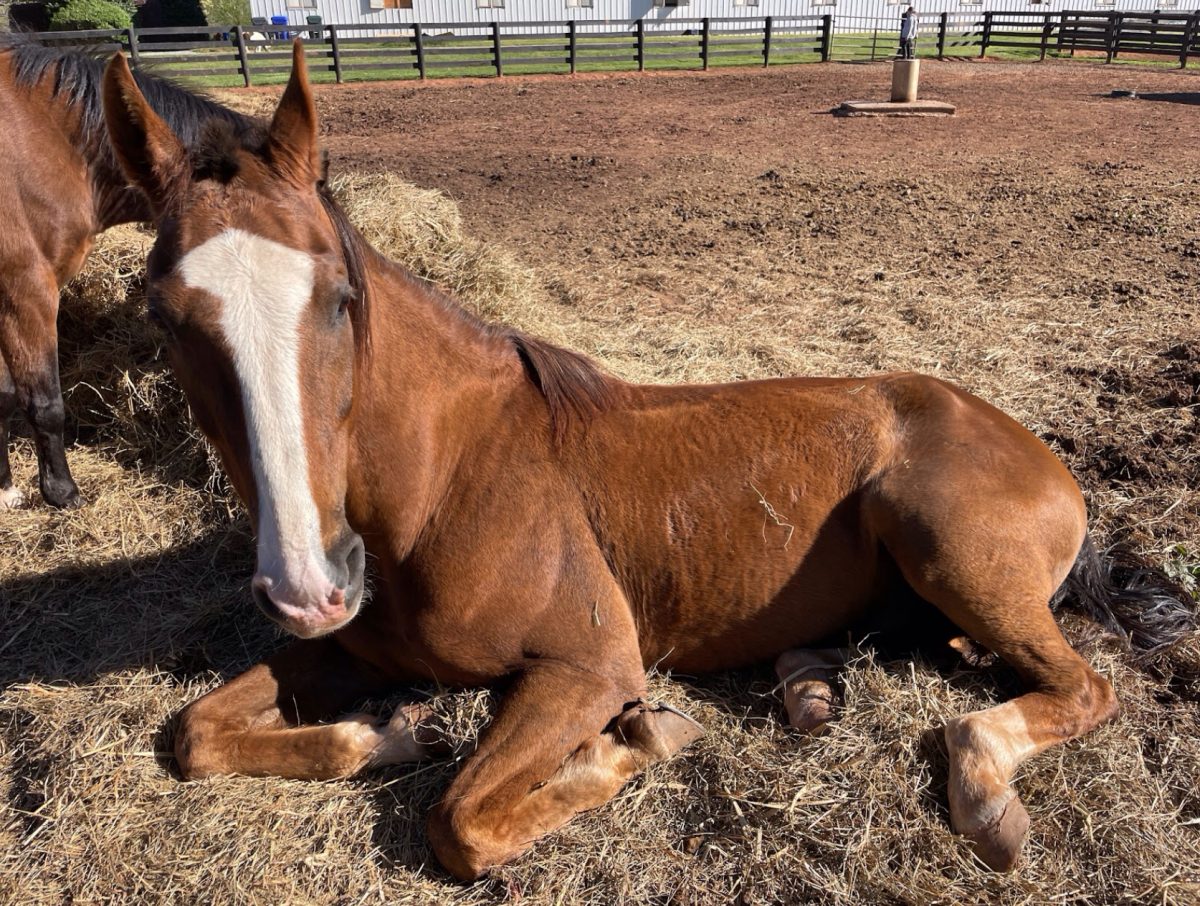On May 9, 2025, Thoroughbred jockey Junior Alvarado, the rider of the Kentucky Derby’s winning horse Sovereignty, was fined $62,000 for striking his horse too many times during the race. He struck the horse eight times during the 2 minute and 2 seconds race, as compared to the accepted six strikes. That’s approximately one strike every 15 seconds.
If an experienced jockey like Alvaredo broke the rules up front, just imagine what else happened back in the pack.
In the aftermath of 2025’s Kentucky Oaks and Kentucky Derby, as well as the Preakness and Belmont Stakes, I’d like to take a moment to share my thoughts on the problematic history and standards which exist in Thoroughbred racing.
I’d like to preface this by saying that there are good and bad trainers in every type of riding, and that this in no way applies to every racehorse owner or trainer. It is a commentary on the general trends of racehorse owners in the industry, and concerning methods used by the industry members.
As an equestrian myself, I’ve seen plenty of barns and riders who treat their horses awfully, but I know none that hold a candle to the number of deaths occurring behind the scenes of Thoroughbred racing.
History
In the United States of America, while horse racing technically started in 1665 with various different breeds, American Thoroughbred racing was elevated in 1894 when the US Jockey Club was established. The Jockey Club acts as the Thoroughbred breed registry to maintain the horse breed in the United States, Canada and Puerto Rico.
This club is still in charge of racing and maintaining Thoroughbred breeding standards today. Partially due to the work of the Jockey Club, horse racing in the US gained popularity in 1919 and has only continued to grow.
In the early days of racing the sport lacked diversity. The majority of jockeys were younger men and boys due to a strong belief that lighter riders made the horses run better, despite the well-known assertion that the necessary muscles for horse jockeying made for riders to be heavier.
Jockey weight was important. In some levels of the sport, men were required to stay below one-hundred pounds. Additional weight came with the risk of not being allowed to compete.
Jockeys often took extreme risks to stay light. Some methods these men used to keep their weights low included excessive dieting, dehydration, vomiting, chewing gum in order to spit out large amounts of saliva, diuretics (water pills, which increase urination), excessive sweating (often done by wearing the hottest, heaviest clothing they can and exercising) and saunas, laxatives, and even tapeworm pills (pills containing tapeworm eggs that would hatch inside the jockey). Some of these practices are still in use today.
At what point does the risk become greater than the reward?
Horses
As for the horses themselves, being hot-blooded (a method of separating horse breeds that refers to generally more reactive and energetic breeds), Thoroughbreds are naturally high-strung animals. As such, they are more sensitive to stressful environments and panic more easily. While their speed makes them ideal for racing, their emotional reactivity does not.
For example, when entering the starting gates, a horse’s temperament can become downright dangerous. Due to the cramped areas and lack of space between each horse, many competitors get injured before the race even begins. If a horse moves too quickly or refuses to enter the gate, it may injure its legs, neck or torso. Riders can also receive injuries when their legs get pinned against the sidewalls. If a horse moves laterally, and other horses are even a risk if their movements manage to hit other riders, too.
However, these animals’ stress is not unwarranted. The suffering for these horses often begins before they are even born, with the mares being forced to mate later than is natural for horses in order to provide the maximum amount of training before the foals begin racing. This pattern continues when these mares are then made to produce another foal in the next year as opposed to their natural two year cycle.
This practice, along with stud services, makes up a large portion of the income of racehorse owners. It is big business. At six months, the foals are taken from their mothers and begin training.
Within the following six months, the foals are put on high-protein diets, rigorous training schedules, and even some types of drugs (which are still unfortunately common, as seen with trainer Bob Baffert, despite regulations against them) in order to make them more appealing in “yearling sales.”
Following these sales, the young horses continue to be trained harshly, and often their schedules result in stress and the breakdown of their underdeveloped skeletal system, making them more susceptible to injuries, especially on their lower legs, which in many cases can be a death sentence. Pain and fear continue to be powerful training motivators during this time, and a majority of these horses suffer injuries long before their first official race.
As strong horses continue to move through the system, being resold to larger and more financially solvent teams, and trainers, the injustice intensifies. Training methods can be insufferable and inhumane. They often include teaching the horses through fear and pain, and those that do not manage to be properly “broken” (a common word in the horse industry for desensitized and obedient) by the training are discarded.
Once horses begin taking part in actual races, which can begin as early as one year and nine months, they are generally confined in solo stalls for up to 22 hours each day, unable to communicate with other horses. This is often when many horses develop repetitive stress-relieving habits, such as cribbing (biting onto an object and sucking in air) and weaving (swaying of the body side-to-side repeatedly). They also develop various other health issues during this time.
Even while actively racing and turning a profit, the horses aren’t treated like living beings, but rather expensive property. In the case of the 2025 Kentucky Derby, the weather and track conditions were wet and sloppy. The reason that the rain didn’t deter any of the horse trainers from running their horses is likely due to the fact that their thoroughbreds are insured, like cars and other high priced performance possessions.
In the case of injury or death of the animal, the insurance money most likely goes towards finding another horse to run.
On top of that, when actively competing in races like the Kentucky Derby, many of these animals are put on drugs that prevent them from recognizing and responding to overexhaustion, meaning that they quite literally run until they can’t anymore.
Following a racehorse’s short career, very few of the horses go to loving homes. While the top performers of the stallions and mares join breeding programs, geldings (infertile males) and horses that won’t otherwise turn a profit are sent to saleyards, where they are most often bought by knackeries (kill shelters) in other countries to be used in pet food.
In fact, one extremely common source of meat for knackeries is ex-racehorses.
On average, a strong horse’s racing career ends before they reach the third year. Weaker horses often don’t often live that long.
Riders
Regarding the riders, we learned in the history section (above) about the weight standards used in previous eras, but even as the sport has grown and changed, today’s weight standards have barely budged. While some of the more extreme methods of weight loss (diuretics and laxatives) were banned due to health concerns, riders are still expected to keep unreasonable weights (between 100 – 120 pounds).
Adult men are still seen as preferable jockeys, but as the sport grows and changes, and some think about lowering the age limit for allowing female riders, male jockeys are making extreme weight decisions. These jockeys still engage in many of the weight loss methods mentioned in the history section.
Even if we ignore the issues that such weight control activities can cause for health, Thoroughbred racing is a high risk sport especially for the rider.
In a situation where a rider falls or is thrown, injury can be catastrophic and life-threatening. The best case scenario is that the horse/rider duo is at the back of the racehorses, and only the rider goes down, hitting the ground at speeds around 40 miles per hour. This speed easily risks damage to internal organs, and often results in death.
In cases where both horse and rider go down, the risk goes up significantly. If (and when) a several thousand pound horse lands either directly or partially on top of the rider, Both moving at speed, the aftermath often results in the death of both horse and rider.
Even in cases where the horse survives, if it sustains a leg injury it will most likely be put down due to the stress of horses weight on their legs making euthanization the only humane option.
The worst case scenario, in which a rider and horse both go down at the front of the charge, can result in the death of several horse-rider duos. As the galloping horses, unable to easily maneuver away from the straight path, barrel forward towards the fallen horse and rider, the original duo is inevitably trampled and kicked by the horses who pass them. In the chaos, many of the other horses may panic and throw their riders, or even stumble over one of the bodies and fall themselves.
Given the history of the sport, and the treatment of both the horses and the riders, how long can we allow this sport to continue along its current path?
While extremely profitable and entertaining to many people, Thoroughbred racing is a risky and dangerous industry that disregards the health and safety of both horse and jockey. Thoroughbred racing is overall a highly toxic industry that survives off of the abuse and death of horses and riders.
The time for a change is now.








